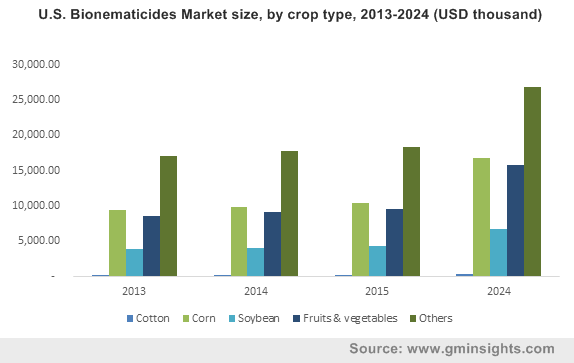U.S. to stimulate bionematicides market trends over 2016-2024
U.S. Bionematicides Market size, by crop type, 2013-2024 (USD thousand)

Based on the crops, bionematicides market is mainly segmented into soybean, corn, cotton, and fruits & vegetables. Corn industry will grow at an annual growth rate of more than 4.5% over the period of 2016 to 2024, owing to the growing demand of bionematicides to improve crop productivity and reduce plant diseases. Fruits & vegetables crop collected a revenue of around USD 41 million in 2015, is projected to grow noticeably over the coming timeframe. The shifting trends towards the consumption of bio-based and organic fruits & vegetables will also favorably impact bionematicides market value.
Get a Sample Copy of this Report @ https://www.gminsights.com/request-sample/detail/783
The cotton crop was worth more than USD 800 thousand in 2015 and is predicted to exhibit significant growth rate over the coming seven years. Bionematicides are prominently used to control the various nematodes such as sting, root knot, lance and cyst, which collectively reduced the crop revenue by USD 80 billion.
Taking into account the regional landscape, Asia Pacific bionematicides industry is predicted to register an annual growth rate of more than 4% over the coming period of 2016 to 2024, mainly driven by the increasing population as well as industrialization. Moreover, sustainability, demographic shifts, and rising environmental concerns will also be the attributing factors toward market growth. The government is supporting the farmers by providing subsidies and loans to promote sustainable farming. India, China, and Japan will contribute considerably towards the APAC bionematicides industry share.
North America bionematicides market will exhibit considerable growth rate over the coming seven years. U.S., having dominated the regional industry share by collecting worth USD 42 million in 2015, is expected to generate considerable revenue over the coming years. The primary attributing factor towards the market growth is the escalating usage of bio-pesticides as opposed to chemical pesticides. Additionally, shifting trends towards agricultural biotechnology like microbe-based pest control will enhance bionematicides industry share.
Market players are expected to invest heavily in the development activities over the coming years, and will adopt important growth strategies such as acquisitions and collaborations. Key industry participants in bionematicides market are Monsanto Company, Dow AgroSciences LLC., BASF SE, Bayer CropScience AG, and Syngenta AG. Other prominent market players include Marrone Bio Innovations, Inc., Valent BioSciences Corporation, Ecoman Biotech Co., Ltd., Certis USA LLC., and LAM International.
Author Name :Sunil Hebbalkar
